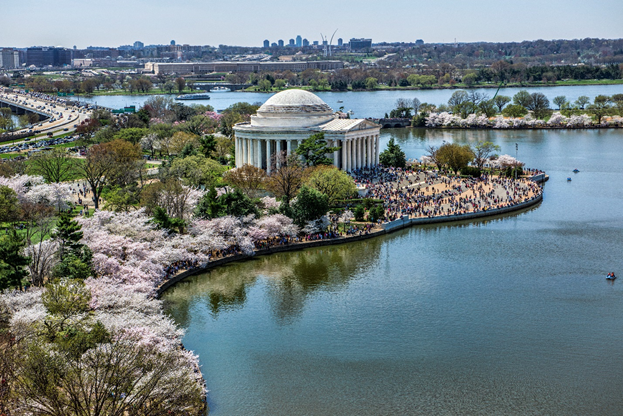News Release

NPS/USPP
News Release Date: April 25, 2017
Contact: Jeremy Barnum, 202-619-7177
|
WASHINGTON — A new National Park Service (NPS) report shows that 61,418,617 visitors to national parks in the national capital region spent $1.2 billion in 2016 that resulted in 18,577 jobs and had a cumulative benefit to the regional economy of $1.75 billion. “Visitors from around the world are drawn to the memorials, historic landmarks and natural beauty found in the national parks of the Greater Washington area,” said NPS National Capital Regional Director Bob Vogel. “Whether they are taking a school field trip to the National Mall, enjoying a day hike in Catoctin Mountain Park, or retracing Civil War history at Manassas National Battlefield, visitors to national parks take away lasting memories and leave behind an important contribution to our region’s economy.” The report shows that national park tourism is a significant driver in the national economy - returning $10 for every $1 invested in the National Park Service. There are 33 national parks in the national capital region which were included in the report. They are: · Antietam National Battlefield (Maryland) · Arlington House, The Robert E. Lee Memorial (Virginia) · Belmont-Paul Women's Equality National Monument (District of Columbia) · Catoctin Mountain Park (Maryland) · Chesapeake and Ohio Canal National Historical Park (District of Columbia, Maryland and West Virginia) · Clara Barton National Historic Site (Maryland) · Ford’s Theatre National Historic Site (District of Columbia) · Fort Washington Park (Maryland) · Franklin Delano Roosevelt Memorial (District of Columbia) · Frederick Douglass National Historic Site (District of Columbia) · George Washington Memorial Parkway (District of Columbia, Maryland and Virginia) · Greenbelt Park (Maryland) · Harpers Ferry National Historical Park (Maryland, Virginia and West Virginia) · Korean War Veterans Memorial (District of Columbia) · Lincoln Memorial (District of Columbia) · Lyndon Baines Johnson Memorial Grove on the Potomac (District of Columbia) · Manassas National Battlefield Park (Virginia) · Martin Luther King, Jr. Memorial (District of Columbia) · Mary McLeod Bethune Council House National Historic Site (District of Columbia) · Monocacy National Battlefield (Maryland) · National Capital Parks - East (District of Columbia and Maryland) · National Mall & Memorial Parks (District of Columbia, some monuments and memorials listed separately) · Pennsylvania Avenue National Historic Site (District of Columbia) · Piscataway Park (Maryland) · President's Park (District of Columbia) · Prince William Forest Park (Virginia) · Rock Creek Park (District of Columbia) · Theodore Roosevelt Island (District of Columbia) · Thomas Jefferson Memorial (District of Columbia) · Vietnam Veterans Memorial (District of Columbia) · Washington Monument (District of Columbia) · Wolf Trap National Park for the Performing Arts (Virginia) · World War II Memorial (District of Columbia) The peer-reviewed visitor spending analysis was conducted by economists Catherine Cullinane Thomas of the U.S. Geological Survey and Lynne Koontz of the National Park Service. The report shows $18.4 billion of direct spending by 331 million park visitors in communities within 60 miles of a national park. This spending supported 318,000 jobs nationally; 271,544 of those jobs are found in these gateway communities. The cumulative benefit to the U.S. economy was $ 34.9 billion. According to the 2016 report, most park visitor spending was for lodging (31.2 percent) followed by food and beverages (27.2 percent), gas and oil (11.7 percent), admissions and fees (10.2 percent), souvenirs and other expenses (9.7 percent), local transportation (7.4 percent), and camping fees (2.5%). Report authors this year produced an interactive tool. Users can explore current year visitor spending, jobs, labor income, value added, and output effects by sector for national, state, and local economies. Users can also view year-by-year trend data. The interactive tool and report are available at the NPS Social Science Program webpage: https://www.nps.gov/subjects/s The report includes information for visitor spending by park and by state. To learn more about national parks in the national capital region and how the National Park Service works with communities in the District of Columbia, Maryland, Virginia and West Virginia to help preserve local history, conserve the environment, and provide outdoor recreation, go to www.nps.gov/locations/dc. |
Last updated: April 28, 2017
